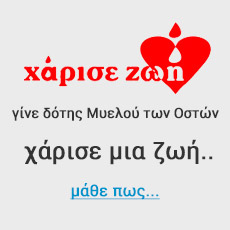Λίστα αντικειμένων
Long term results of the phase III study were published. They confirm
our practice in our Tx center
Presenter: Prof. Spyridondis
Particpants: Dr Liga, Dr Spyridis, Dr Verigou
Acute GVHD prophylaxis plus ATLG after myeloablative allogeneic
haemopoietic peripheral blood stem-cell transplantation from
HLA-identical siblings in patients with acute myeloid leukaemia in
remission: final results of quality of life and long-term outcome
analysis of a phase 3 randomised study.
Lancet Haematol. 2019 Feb;6(2):e89-e99. doi:
10.1016/S2352-3026(18)30214-X.
Abstract
BACKGROUND:
We previously showed that human anti-T-lymphocyte globulin (ATLG) plus
ciclosporin and methotrexate given to patients with acute leukaemia in
remission, having allogeneic haemopoietic stem-cell transplantation with
peripheral blood stem cells from an HLA-identical sibling donor after
myeloablative conditioning, significantly reduced 2-year chronic
graft-versus-host disease (cGVHD) incidence and severity, without
increasing disease relapse and infections, and improves cGVHD-free and
relapse-free survival (cGRFS). The aim of an extended follow-up study
was the assessment of long-term outcomes, which are, in this context,
scarcely reported in the literature. We report unpublished data on
quality of life (QoL) from the original study and the results of a
follow-up extension.
METHODS:
In the original open-label study, patients with acute myeloid and
lymphoblastic leukaemia in first or subsequent remission, having sibling
HLA-identical allogeneic peripheral blood stem-cell transplantation,
were randomly assigned (1:1) to receive ATLG plus standard GVHD
prophylaxis with ciclosporin and short-term methotrexate (ATLG group) or
standard GVHD prophylaxis without ATLG (non-ATLG group). Conditioning
regimens were cyclophosphamide 120 mg/kg with either total body
irradiation (12 Gy) or busulfan (12·8 mg/kg intravenously or 16 mg/kg
orally), with or without etoposide (30-60 mg/kg). Randomisation was
stratified according to centre and disease risk. The primary endpoint
was cumulative incidence of cGVHD at 2 years. The primary and secondary
endpoints, excluding QoL, have been published. QoL, assessed using
European Organisation for Research and Treatment of Cancer QLQ-C30 and
QLQ-HDC29 questionnaires, was an unpublished secondary endpoint, which
we now report here. A follow-up extension was then done, with the
primary endpoint cumulative incidence of cGVHD. Enrolment has been
completed for both studies. The original trial (number, NCT00678275) and
follow-up extension (number, NCT03042676) are registered at
ClinicalTrials.gov.
FINDINGS:
In the original study, from Dec 14, 2006, to Feb 2, 2012, 161 patients
were enrolled and 155 were randomly assigned to either the ATLG group
(n=83) or to the non-ATLG group (n=72). In the follow-up study, which
started on Feb 7, 2017, and was completed on June 30, 2017, 61 patients
were included in the ATLG group and 53 were included in the non-ATLG
group. Global health status showed a more favourable time course in the
ATLG group compared with the non-ATLG group (p=0·02; treatment by visit
interaction). ATLG was descriptively superior to non-ATLG at 24 months
for physical function (points estimate -14·8 [95% CI -26·4 to -3·1];
p=0·014) and social function (-19·1 [-38·0 to -0·2]; p=0·047),
gastrointestinal side-effects (8·8 [2·5-15·1]; p=0·008) and effect on
family (13·5 [1·2-25·8]; p=0·032). Extended follow-up (median 5·9 years
[IQR 1·7-7·9]) confirmed a lower 5-year cGVHD incidence (30·0% [95% CI
21·4-41·9] vs 69·1% [59·1-80·1]; analysis for entire follow-up,
p<0·001), no increase in relapses (35·4% [26·4-47·5] vs 22·5%
[14·6-34·7]; p=0·09), improved cGRFS (34·3% [24·2-44·5] vs 13·9%
[7·1-22·9]; p=0·005), and fewer patients still in immunosuppression
(9·6% vs 28·3%; p=0·017) in the ATLG group compared with the non-ATLG
group. 5-year overall survival, relapse-free survival, and non-relapse
mortality did not differ significantly between groups.
INTERPRETATION:
The addition of ATLG to standard GVHD prophylaxis improves the
probability of surviving without disease relapse and cGVHD after
myeloablative peripheral blood stem-cell transplantation from an
HLA-identical sibling donor for patients with acute leukaemia in
remission. Further additional benefits are better QoL and shorter
immunosuppressive treatment compared with standard GVHD prophylaxis
without ATLG. Therefore, in this setting, ATLG plus standard GVHD
prophylaxis should be preferred over the standard GVHD prophylaxis
alone.

